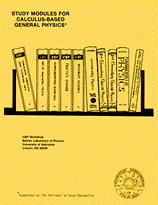Instructional Materials in Physics and Astronomy
Date of this Version
1975
Document Type
Article
Abstract
Everyone has seen a bar magnet in the form of a compass or a door catch. Anyone who has ever casually played with magnets or magnetic toys knows that magnets interact with other magnets; i.e., a magnet experiences a force caused by thp presence of an external magnetic field produced by the other magnet. A wire carrying a current experiences a force caused by the presence of a nearby magnet (as you saw in the module Magnetic Forces). We then expect the converse to also hold true, i.e., that the bar magnet will also experience a force from the presence of the current-carrying wire. This expectation can be verified experimentally by putting a compass needle near a current-carrying wire.
Thus both a bar magnet and a current-carrying wire produce a magnetic field. A bar magnet, however, cannot be broken down into a single magnetic pole similar to the electric charge. Even on the atomic scale, there are always two magnetic poles similar to the two magnetic poles produced by a small loop of current-carrying wire. A bar magnet is really just a collection of atomic current loops or charges in motion. In this module (and the module Magnetic Forces), you are actually investigating the interaction at a distance of moving electric charges (e.g., electric currents). The intermediary in this interaction is the magnetic field B(r). By introducing B, you separate the interaction into two parts: (1) creation of the B field by given currents (to be treated in this module), and (2) the action of this field on other given currents or moving charges (which you studied in Magnetic Forces).
Along beside the other memorable force relations involving magnetic fields, you will now add to your collection of fond memories the field relations known as Ampere's Law and the Biot-Savart Law. (Please note: The latter is pronounced Bee-oh Sah-var'.)



Comments
From Study Modules for Calculus-Based General Physics
Copyright © 1975 CBP Workshop, University of Nebraska–Lincoln.
Reproduction rights granted.